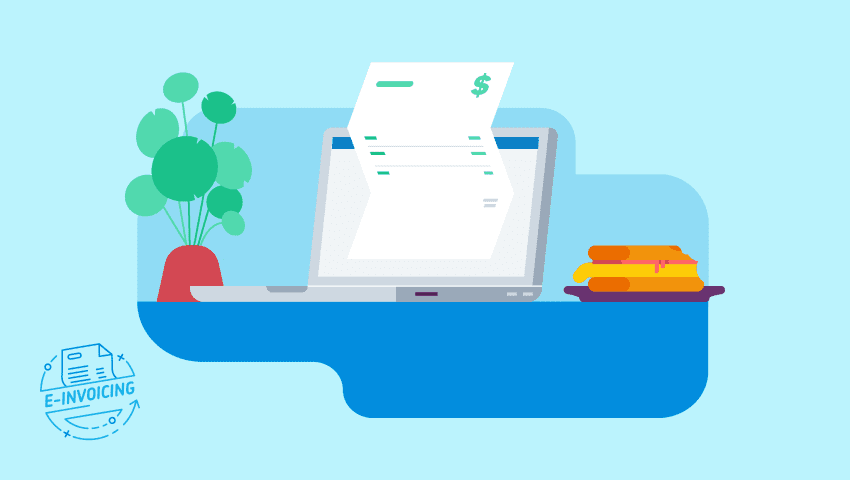

Invoicing admin can be hugely time consuming for advisors. From chasing clients for financial documents to manually entering details into software, this process can cause plenty of headaches for those involved. Luckily, there is a solution to be found. E-invoicing, a new way to exchange invoices directly between accounting software, is set to improve the accounts payable and receivable experience.
How? It removes the hard parts of traditional invoicing and makes the entire process not only faster, but more secure, accurate and efficient. For advisors who spend their days managing these tasks, shifting to e-invoicing holds the promise of a streamlined workflow – allowing you to focus on more important work. It is also an important step in the digitisation of small businesses across the nation and promises to bring wide-ranging benefits (from aiding in solving the longstanding late payments issue, to boosting security).
While the network is still growing, more businesses of all sizes as well as government agencies are joining each day. Here at Xero, we’re pleased to be helping make e-invoicing a reality as one of the first major providers of small business accounting software to offer it in Australia. Recently, we heard from you, our partner community, on what you want to know about the move to e-invoicing. Here are your top questions answered:
How do I set up e-invoicing within Xero?
There are two elements to using e-invoicing – sending and receiving. To be able to send e-invoices, you’ll need to follow the steps here.
Make sure you’re on the new invoicing setting in Xero on your desktop, as the ability to send e-invoices is only available on this setting. If you’re using classic invoicing, you can click ‘Switch to new invoicing’ at the bottom of the invoice screen.
When it comes to receiving e-invoices, you’ll need to register via Xero. Once logged in on your desktop, this takes just a few easy steps that you can follow here.
Do I need to use a separate platform to Xero to access e-invoicing?
No, you do not. Xero is an accredited e-invoicing Access Point and this is included in your subscription. This means you are able to send and receive e-invoices within Xero, without any additional add-ons or external services.
You do, however, need to make sure you’re registered to receive e-invoices, which can be done in the bills to pay section of Xero in a few easy clicks.
Does using e-invoicing cost extra?
E-invoicing is included in Starter, Standard and Premium Xero subscriptions.
Will advisors need to register separately to their clients?
Customers with advisor user role access can register on behalf of their clients to receive e-invoices. Once you have done this, your client will not have to register themselves or make any changes. This has to be done individually for each business you work with.
How can I check if my client’s customers and suppliers are registered for e-invoicing?
You can check if a business is registered on the e-invoicing network via the Peppol directory. If they aren’t, suggest they register with their accounting software so you can begin sending them e-invoices.
Do both the sender and receiver need to be registered?
No, you only need to register to receive e-invoices. Both parties do need to use software that is connected to the Peppol network, however, for it to work. This can be any accredited e-invoicing Access Point, not just Xero, and some government agencies are already able to receive e-invoices.
How do I know if a client has received an e-invoice?
If they are registered for e-invoicing, the invoice will arrive into Xero as a draft bill waiting to be approved and paid. Keep an eye out for these as it may be a little different to your usual process – no more digging through emails and manually entering details.
How does e-invoicing work if I’m already using Hubdoc?
E-invoicing and Hubdoc can work in conjunction as not all invoices will be able to be delivered via e-invoicing. You will likely still receive invoices in the mail, via email, or by other means. Hubdoc ensures that no matter how an invoice is delivered to you, there’s usually an easy, no-stress way to get it into Xero that doesn’t require you to manually transcribe all the invoice details.
Can I register overseas clients?
Currently, Xero supports e-invoicing in Australia, New Zealand and Singapore. You are able to register them depending on the guidelines in each of those countries.
While you are able to register them from Australia, initially, you will only be able to send an e-invoice from Xero to another business or government department in the same country. We will extend this capability to support international trade in due course, where markets are covered by the Peppol network.
Does e-invoicing have the usual invoicing measures I’m used to, like duplicate invoicing checking?
Yes – since it is within the usual Xero platform, it uses many of the features you know and love. For example, you can continue to use invoice reminders when sending an e-invoice. Duplication is a challenge with e-invoicing, irrespective of how the invoice is currently processed (for example, email-to-bills, repeating bills, bank reconciliation/spend money all have the same issue). Since e-invoicing flows into ‘Draft Bills’, it will indicate that there is a duplicate ‘Reference’ before the draft is approved.
For more information on e-invoicing and what it means for advisors and your small business clients, visit the Xero website. And, as always, don’t hesitate to let us know if you have more questions.




